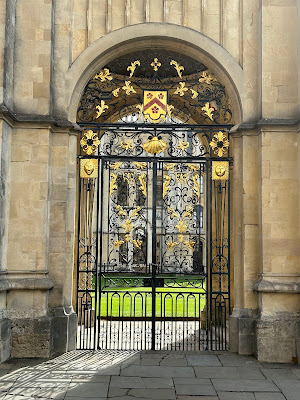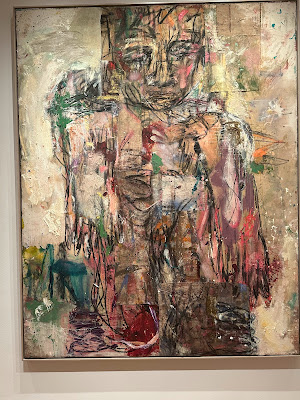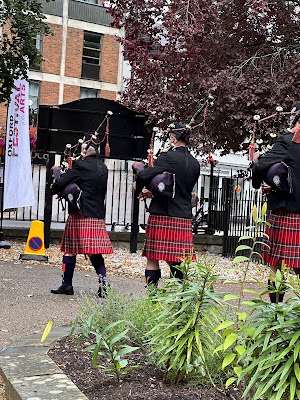What do you do in a world in which nothing opens before 10:00? You go for a walk. That is what you do. So I started out on a city walk of Oxford taking a few detours to inspect little alleys or enticing mini-parks.
Por ejemplo:
View from a bridge of punting boats waiting for 10:00:
An olde house that has been waiting a long time:
This being Oxford and all, there are lots of spires:
Gate to a college:
I had not finished the walk but it was after 10:00 and I was near the Ashmolean Museum, which is the museum everyone comes to Oxford to see, so I went in.
This guy shows you where to start:
The museum has the most eclectic collection you can imagine and it is often—but not always—well curated. For example, in the textile section they explain what makes textiles decay (insects and light are two major factors), how they determine that and how they can repair some fabrics. Unfortunately, I could not read most of the signage and the robes and such were dimly lit (see 'light' above, although I think they are referring to a different kind of light), which was frustrating. One robe was called "The Lawrence Robe," I assume they were referring to THAT Lawrence because it was Arab garb and the most stunning gold and white fabric.
The piece below, was not in bad light and you are looking at the front not the back. It is a Match-coat from Canada, 1656. Back of tunic made of caribou hide, and decorated with fringes, bands of porcupine quillwork, and beads made of beaver-claws. This is probably the oldest known surviving Indigenous North American leather garment and is unique.
In that case, what is it doing here?
I have no idea what the detail of this embroidered fabric is, but the entire piece was stunning:

I will confess that there was a ton of stuff I was not interested in and a good thing, too, or it would have taken days to go through the museum. An impressive display of Chinese paintings you were not allowed to photograph and another room of artwork you were not allowed to photograph, which was a shame because some of the framing was whacko, and there was a Picasso that you would never guess was a Picasso. You will just have to take my word, or better still, come and see for yourself!
On to the photo-allowable.
Flora Yukhnovich
Hell is a Teenage Girl, 2023
The title of this energetic painting references the first words spoken by Needy, one of the main characters in the American horror film Jennifer's Body (2009). As inspiration for her new paintings, Yukhnovich watched horror films that are concerned with coming of age and archetypical motifs around the female body and reproduction. The cliché of virtuous and innocent femininity, typically represented by a virgin, is often contrasted with unbounded, carnal femininity. In Jennifer's Body, the wild aspect is personified by the attractive but demonised femme fatale character. Jennifer (Megan Fox). Oil on linen Flora Yukhnovich. Courtesy the artist and Victoria Miro
I know the photos should be cropped and all but no time! I hope the above narrative is the artist speaking!
Daniel Crews-Chubb Immortal XVI, 2022
The abstracted figure here conveys a self- contained and thoughtful expression. Despite being informed by deities and fantastical figures from ancient history, Crews-Chubb's work is nonetheless concerned deeply with the human condition today.
With my work, I'm not trying to make something decorative. I'm trying to make something that I think is powerful, outward looking, which makes you ask what it is to be human.
Oil, oil bar, acrylic, ink, charcoal, spray paint, sand, coarse pumice gel and collaged fabrics on canvas Daniel Crews-Chubb, courtesy Timothy Taylor, London / New York
I think this painting works better without the pretentious philosophy.
No one will know what this is, but I will venture a guess that it weighed a ton.
It is:
The Lord Chancellor's seal purse
1850, England, velvet, silk, wire, embroidered with silk and metal thread couching. Official purse of the Lord Chancellor Wilde (1850-1852), first Baron Truro. The purse was used to carry the Great Seal of the United Kingdom, the royal seal attached to documents of state.
There was a room devoted to writing as in ancient scripts, but I would have to go into a rant if I said anything about the display so no info on writing.
One final gem from the Ashmolean:
Cherry Blossom Blizzard (E) 2013
The villainous warrior Daizen imprisons Princess Yuki in the Temple of the Golden Pavilion. He orders the Princess, who is from a family of talented artists, to paint a picture of a dragon on the ceiling. When she refuses, Daizen ties her to a cherry tree and takes her husband away to execute him. As the cherry blossoms fall around her like a snowstorm, the sorrowful Princess gathers up the petals with her toes and draws a mouse with them. The picture is so realistic that it comes to life and gnaws through her ropes to set her free. Hiromitsu has playfully imagined this well-known scene with four white mice.
After the Ashmolean and a little lunch, I headed over to the Botanic Gardens. This is their background story:
Beneath this garden lies a medieval cemetery.
Around 1190 the Jews of Oxford purchased a water meadow outside the city walls to establish a burial ground. In 1231 that land, now occupied by Magdalen College, was appropriated by the Hospital of St John, and a small section of wasteland, where this memorial lies, was given to the Jews for a new cemetery.
An ancient footpath linked this cemetery with the medieval Jewish quarter along Great Jewry Street, now St Aldates. For over 800 years this path has been called 'Deadman's Walk, a name that bears silent witness to a community that contributed to the growth of this City and early University throughout the 12th and 13th centuries.
In 1290 all the Jews were expelled from England by King Edward I. They were not permitted to return for over 350 years.
May their memory be blessed יהא זכרונם לברכה
It was raining, so not too many photos. These giant-whatever-they-are were truly awesome:
There were two specimens of plants described that the the Garden does not have but they are so fascinating, I have to include them.
Fanged Pitcher Plant Nepenthes bicalcarata
This Bornean species has evolved a close relationship with ants. The ants rear their young in the plants' swollen, hollow tendrils. They consume nectar produced around the fangs that project beneath the lid. In return for food and accommodation, the ants viciously attack weevils which try to eat the developing shoots of the plant. This plant needs very hot conditions and does not grow in our collections just yet.
And its cousin:
Bat Pitcher Plant Nepenthes hemsleyana
This plant's slender pitchers lack the fragrance and copious nectar produced by most pitcher plants, and trap fewer insects. Remarkably the pitchers of this plant are a home for woolly bats! This benefits both the bats, which use the pitchers as a safe roosting site, and the plants, which are nourished by the bats' droppings in the nutrient-poor heath forests where they grow. This species is rare in cultivation, and is not grown in our collections just yet.
I also learned that tobacco has killed more people than any other plant and that sugar is not so good for you, in case you did not know.
From the garden, and now that it was way after 10:00 a.m., you could see punters punting. Clearly it is harder than it looks!
There were also pipers piping:
On the way back to the hotel, I noticed that one of the college courtyards was open, so I went in.
Like Yale or not like Yale?
I believe that every college has a chapel:
Good acoustics no doubt.




















No comments:
Post a Comment